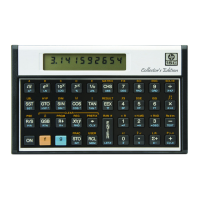Section 10: The Index Register and Loop Control 109
To Labels. If the R
I
value is positive, t V and G V will transfer
execution to the label which corresponds to the number in the Index
register (see the above table).
For instance, if the Index register contains 20.00500, then a t V
instruction will transfer program execution to ´ b A. See the chart
on page 107.
To Line numbers. If the R
I
value is negative, t V causes branching
to that line number (using the absolute value of the integer portion of the
value in R
I
).
For instance, if R
I
contains −20.00500, then a t V instruction will
transfer program execution to program line 020.
Indirect Flag Control With V
F V, " V, or ? V will set, clear, or test the flag (0 to 9)
specified in R
I
(by the magnitude of the integer portion).
Indirect Display Format Control With
V
´ • V, ´ i V, and ´ ^ V will format the display in
their customary manner (refer to pages 58–59), using the number in R
I
(integer part only) for n, which must be from 0 to 9.
*
Loop Control With Counters: I and e
The I (increment and skip if greater than) and e (decrement and
skip if less than or equal to) functions control loop execution by
referencing and altering a loop control number in a given register.
Program execution (skipping a line or not) then depends on that number.
The key sequence is ´ {I, e} register number. This number is 0
to 9, .0 to .9, V, or %.
The Loop Control Number. The format of the loop control number is:
nnnnn.xxxyy, where
±nnnnn
is the current counter value,
xxx
is the test (goal) value, and
yy
is the increment or decrement value.
*
Except when using f (Section 14)

